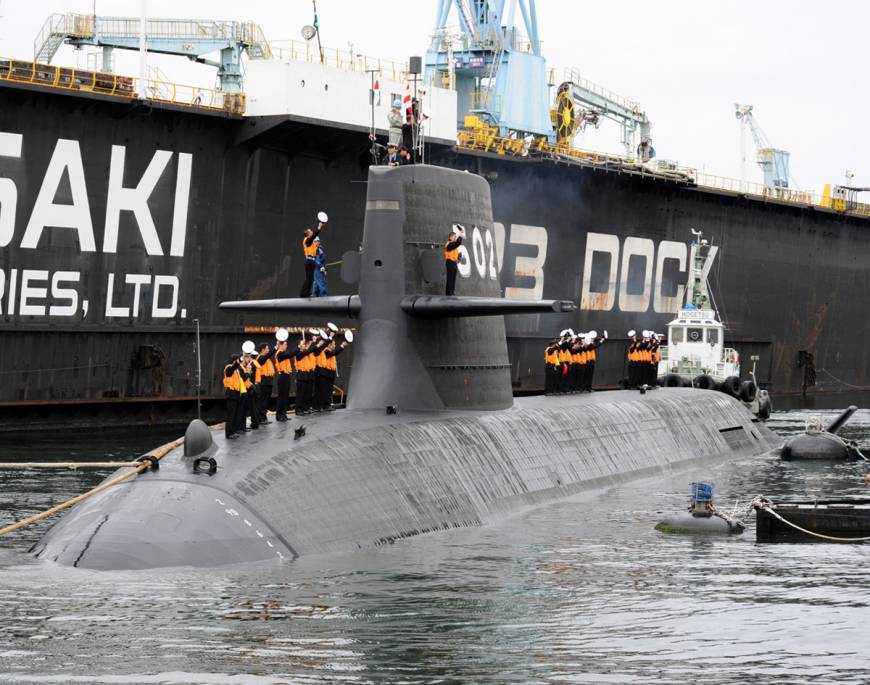Memo #373
By: Thomas Wilkins – thomas.wilkins [at] sydney.edu.au

Nothing is exciting strategic commenters in Australia more than the long drawn out process of competitive evaluation of rival boats for its Collins-class submarine replacement programme. The choice of sub represents a roughly A$50bn investment and the future of Australian naval deterrent capacity into the 2050s. Clearly there are many technical, operational, financial, and political factors that will determine the final decision among the German, French and Japanese bids.
The controversy over ‘Option-J’ began when it appeared that, then Australian PM, Tony Abbott, had made some kind of back-room deal with his counterpart PM Abe during their meetings in 2014. The consequent political storm resulted in an open bidding process that has led to intense scrutiny over the relative merits of the potential submarine tenders. Germany (ThyssenKrupp) and France (Thales-DCNS) have not built subs of the size Australia needs. France would have to change the nuclear propulsion system to diesel-electric, whilst Japan (Mitsubishi-Kawasaki) has no experience at delivering on major international arms orders. But one of the major selection criteria soon emerged from Australian domestic politics –the boats had to be built (at least partially) in Southern Australia (the so-called ‘defence state’). Germany and France were quick to grasp this, but Japan, believing the deal to be a purely military-economic transaction, was slow to realize the importance of the public diplomacy surrounding negotiations. Australia has also driven a hard bargain on technology transfer, again something Tokyo was reluctant to offer initially, hoping that Canberra would simply purchase boats made in Japan ‘off-the shelf’.
Even though some fear China’s displeasure if Japanese boats are selected, according to the 2009 Defence White Paper, the flotilla will remain guardedly pointed in Beijing’s direction. It would be a surprised if Canberra did not select Option-J for a number of reasons. Japan is a close strategic partner, a joint ally of the United States (and the three cooperate through the Trilateral Strategic Dialogue). Moreover, its existing Sōryū-class boats most closely meet Australian requirements, as they are renowned for their stealthy propulsion system. With a relatively strong pro-Japan government in place in Australia, and with the evident blessing of the United States (which has hinted that it will only supply its most sophisticated combat systems for a Japanese boat), Option-J seems the most likely choice, with the final decision scheduled for mid-2016.
About the Author:
Dr. Thomas Wilkins is a Senior Lecturer in the Department of Government and International Relations at the University of Sydney. He specialises in Asian security politics with a particular emphasis on Japanese diplomacy and Australia-Japan bilateral relations. This year he has been awarded a Japan Society for the Promotion of Sciences (JSPS) Fellowship to return to Todai (Tobunken) to continue his research on the above topics. He is also the Associate Editor – Asia General for Pacific Affairs.

Japan’s Sōryū-class submarine (Credit: Japan Ministry of Defense/ Japan Maritime Self-Defense Force)
Links
- Erika Pollmann & Alan Tidwell, “Australia’s submarine technology cooperation with Japan as burden-sharing with the USA in the Asia-Pacific,” Australian Journal of International Affairs, 69, no. 4 (2015): 394-413.
- Bee Yun Jo, “Japan Inc.’s remilitarization? A firm-centric analysis on Mitsubishi Heavy Industries and Japan’s defense industry in the new-TPAE regime,” International Relations of the Asia Pacific, 16, no. 1 (2016): 137-166.
- Thomas Wilkins, “The Japan choice: reconsidering the risks and opportunities of the ‘Special Relationship’ for Australia,” International Relations of the Asia Pacific 2015. First published December 15, 2015, doi:10.1093/irap/lcv025.
- Thomas Wilkins, ‘From “Strategic Partnership” to “Strategic ‘Alliance”? ‘Australia-Japan Security Ties and the Asia-Pacific.’ Asia Policy, no. 20 (July 2015): 81-111.
- Paul Osborne, “Sub decision can come before poll: Labor,” Australian Associated Press, 6 April 2016.
- Mick Ryan, “The Japanese Sōryū-class Submarine: its potential to meet Australia’s requirement,” Australian Defence Force Journal, 189 (2012): 21-33.
- Rex Patrick, “SEA 1000 – Speculation about the Origins of Option J,” Asia Pacific Defence Reporter (4 July 2015).
- “Defence industry wants commitment to a local build before election,” Asia Pacific Defence Reporter (6 April 2016).
Whatever Australia decides, the result will certainly be better than Canada’s decision a few years ago to buy second hand British subs. One caught fire on the way to Canada, with the loss of a life, and the others have spent as much time in refits as at sea.